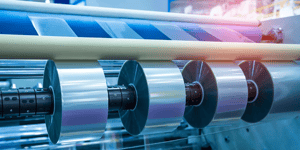Have you ever gone to peel a sticker but couldn’t remove it from the sheet?
Adhesive release liners are all around you, but it’s only when they start to malfunction that people tend to notice.
When working on a product, you’ll want the release liner to fit seamlessly into your application process. Whether cutting, adding, or stripping adhesive liners away, Strouse constantly tests and adapts liners for our clients’ needs.
Before you go hunting for adhesive liners, allow us to review what they are, the different types, and how to match a liner to the application so you can achieve the best project results possible.
What are Adhesive Release Liners?
As a converter of flexible materials, we love to talk about pressure sensitive adhesives (PSA). However, the unsung hero of the adhesive world may be the release liner, also known as the “carrier” or “backing.”
Adhesive release liners — typically a coated paper or film — carry the sticky adhesive and serve as a protective covering until the pressure-sensitive adhesive is needed. You probably know them as the shiny paper that carries a sticker or label.
In many cases, the release liner is one of the most critical decisions when designing a PSA. It has to have the right qualities and features to precisely match the application (hand-applied or automatic dispensing) and processing (slitting, die-cutting, etc.). The good news? You have a LOT of options.
Types of Adhesive Release Liners
A release liner’s base may be paper, polycoated paper, film, or metalized film. The liner itself can be coated with silicone or non-silicone to ease separation from the adhesive.
As we’ll discuss further, the customization of your liner depends on the precise delivery or dispensing system needed for the application. For now, here are the three primary materials used for adhesive release liners:
- Paper — The most common release liners, paper is offered in four main types: Densified Kraft (DK), Extended Densified Kraft (XL), Polycoated Kraft (PCK), and Extensible Polycoated Kraft (EK).
- Film — Film release liners are steadily increasing, especially for labels and tapes, industrial (roofing shingles, insulation products), and medical/hygiene (electrodes, wound dressings, diapers, etc.). Film liners generally have two types: Polyester (PET) and High-Density Polyethylene (HDPE).
- Specialty — These release liners include specialized film (such as metalized film) and other unique substrates for highly specialized applications in various industries (aerospace, automotive, wind energy, etc.).
Manufacturers coat a release agent on liners (often silicone but not always) to laminate and protect the adhesive it is applying to from exposure before use. The “release level” is the degree of separation of the adhesive from the substrate, ultimately dictating the release liner's characteristics.
MATCHING A RELEASE LINER TO THE APPLICATION
Pairing your custom-converted adhesive part with the optimal liner is crucial for many applications, including automatic assembly processes.
For instance, let’s say a print company is preparing inkjet cartridges. It’s critical to the automated assembly process that the release liner performs well so the components can release from the liner as intended and dispense onto the cartridge accurately.
Release liners come in different formats:
- Easy, medium, or tight release
- Single- or double-sided release
- Printed
- Medical grade
- Extended liner for easy removal
- Split back
And other adhesive features so they can fit more use cases.
Finding an Adhesive Release Liner
Choosing the right adhesive release liner will give you a quick and easy application, but how do you make a good selection?
If you need help finding a suitable adhesive release liner, consider seeking advice from your adhesive converter. Many converters offer sampling and prototyping services that allow you to test the part before you invest in full-stage production.
Plus, an experienced converter has handled many types of material and will invest in understanding your product from start to finish. The best converters can also adjust to working with customers who supply their own materials or release liners for a converted part.
If you’re unsure about your design or materials, you can get your part evaluated for manufacturability.
Originally published: September 30, 2020
.jpeg?width=290&name=0%20(1).jpeg)






